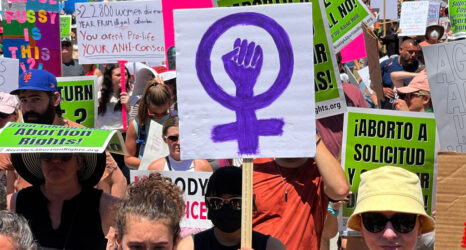I am not 22.
I am not single.
I am not what they wish I was.
I am not the stereotype that the anti-choice crowd claims all abortion-seekers are. I am a mother of two who loves her daughters deeply, and their father is my first and only husband. Both of our kids were conceived after we said “I do” and had bought a house with a white picket fence in my parents’ neighborhood. I am also the face of someone who could be hurt by abortion becoming inaccessible, practically or legally.
Giving birth to my second daughter almost killed me. The doctors wouldn’t agree to a C-section even though my water had broken, I was past my due date, and my daughter was breech. They sent me home twice. When I was finally admitted, I had multiple tears in my uterus, two in my cervix and one in my vagina that was over an inch long. I lost four pints of fluid on the table. When my blood pressure hit 40/28, my husband was removed from the operating room. The doctor wasn’t terribly concerned with stitching me up well, just quickly. My obstetrician told me as I was being discharged that he was sure I was going to die and they wanted me to die in recovery. As a result, I didn’t heal right and can’t safely carry another pregnancy to term.
I need abortion providers to be available in case my tubal ligation ever fails. When I healed, my uterus fused to my abdominal cavity. The best guess is that I could maybe make it to 30 weeks before my uterus ruptured and I bled to death. I have three choices: hope that a doctor would induce at 25 weeks (not likely); have an abortion; or die. I don’t want my daughters to grow up without a mom.
Who I am is someone who will be affected by the Supreme Court’s ruling in Whole Women’s Health v. Hellerstedt. If I live in a state like Texas where the abortion laws are set up to severely limit the number of open clinics open, it would affect the speed with which I could receive a life-saving procedure. Seven or eight clinics closing in Texas would increase the current 111-mile average to the nearest abortion provider in the state. It would increase the cost of the procedure by an estimated 15 percent, to $701. This doesn’t include the multitude of insults that the women of Texas already have to endure. I would have to have an ultrasound, have the fetus described to me and be told medically incorrect information. They would try to change my mind from wanting to live to wanting both me and the baby to die.
In New York, however, I could go to my Planned Parenthood, get a referral and get an abortion. No one forcing me to have an ultrasound, making me come back in 24 hours or telling me medically incorrect statements about the ‘harms’ of the procedure. There aren’t legally mandated scare tactics to try and talk a grown woman out of a medical decision in that state. The clinics aren’t required to have 8-foot-wide hallways just in case. The mortality rate from abortion overall is 0.0006 percent; small hallways isn’t increasing that number. In New York, the state trusts I can make up my own mind about my medical choices and trusts the clinics to be capable.
These restrictive laws that we hear over and over again are there to “protect women’s health” are not, at least not in my case. They are a potential harm to my health. I would like for there to be an open conversation about cases like mine.
The faces of people these laws are hurting need to be seen. Some see me as nothing more than a potential baby-killer. I see myself as being willing to use all means of self-defense. We might not be able to have a rational conversation, but we have to have rational laws—for me and women like me. For some of us, that rationality could mean the difference between seeing our kids grow up and leaving behind orphans.
Photo courtesy of Flickr user AlisaRyan licensed under Creative Commons 2.0





